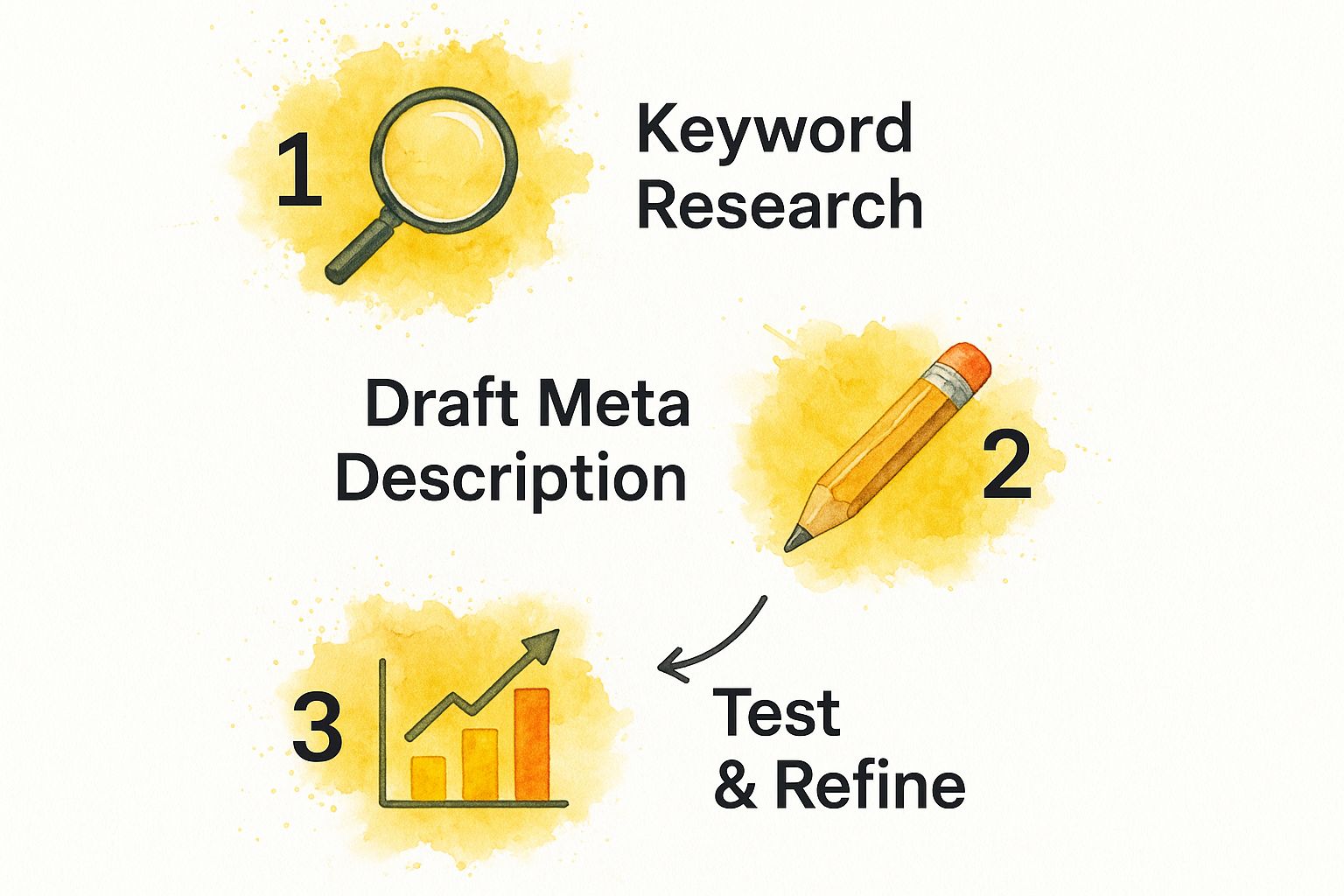How to Write Meta Descriptions That Actually Drive Clicks
Why Meta Descriptions Matter More Than You Think
It’s tempting to treat meta descriptions as just another task on your SEO to-do list. We often get caught up in the race to the top of the search rankings, but what’s the point of getting there if no one clicks on your link? Think of your meta description as your 155-character sales pitch on a very crowded shelf. After your title, it’s the most powerful tool you have to persuade someone to choose your result over all the others.

From Afterthought to Advertisement
Stop thinking of it as a summary and start seeing it as a mini-ad. Does it spark curiosity? Does it hint at a solution to a problem? Does it promise real value? A great meta description that drives clicks will answer "yes" to these questions. Recognizing this is a core part of effective SEO services, as these short descriptions directly impact how users engage with your site in search results. When you treat this small piece of text as a vital conversion tool, you can see a real lift in organic traffic, even without changing your rank.
The potential here is bigger than you might realize. Some studies show that a surprising 25% of top search results don't have a meta description at all. This is a huge opportunity for you to make your listing pop. In fact, pages with unique, well-written descriptions often see their click-through rates (CTR) jump by 5% to 30%. This simple tweak could be the deciding factor that sends a visitor to your site instead of a competitor's. To get ahead of the curve, you can learn more about the best practices for meta tags in 2025.
The Psychology of the Click
So, what really makes someone click one link over another? It usually boils down to a quick judgment call based on relevance and appeal. A powerful description connects with a user's search intent on a human level. It's not about stuffing keywords; it's about speaking directly to the searcher's needs.
For instance, a description promising a "quick 5-minute guide" appeals to someone in a hurry, while another highlighting "expert-backed tips" builds immediate trust. This is the secret to how to write meta descriptions that truly perform and win that all-important click.
Getting the Length and Format Just Right
Let’s get into the details of writing a meta description that search engines actually want to show. While there isn't a single magic formula, understanding the technical rules is the first step to winning the click. This is about more than just avoiding the dreaded "..." at the end of your text; it’s about making sure Google doesn’t decide to rewrite the whole thing for you.
Finding the Sweet Spot for Length
Even though Google doesn’t have a strict character limit, the space on a search engine results page (SERP) is limited. The goal is to write a description that’s compelling enough to draw someone in but short enough to be fully visible. For years, the magic number was around 155 characters. That's still a decent guideline, but the reality is a bit more flexible these days.
Meta descriptions are a key part of any SEO strategy because they directly influence whether a user clicks, even if they don't directly affect your rankings. Right now, the optimal length is widely considered to be between 140 and 160 characters. This gives you enough space to explain the value of your page while reducing the risk of your message getting cut off, which can weaken its impact and lower your click-through rate. You can find out more by exploring insights on SEO meta descriptions from Search Engine Land.
When you're trying to write the perfect meta description, counting every character by hand is a pain. Using a simple character counter tool can make this much easier, helping you stay in that ideal range without the guesswork.
Formatting for Maximum Impact
Beyond just the length, a few formatting tricks can help your description pop. Think of it as writing a tiny, powerful ad for your page.
- Write in an active voice: Kick things off with a verb whenever you can. Instead of a passive phrase like "This guide is about...," try something more direct like "Learn how to..." or "Discover the best..." It feels more immediate and actionable.
- Include your focus keyword: Google often bolds the search term within descriptions. This instantly grabs the user's attention and confirms your page is relevant to what they were looking for.
- Think about special characters: Don't go overboard, but a well-placed character like an ampersand (&) or even a checkmark emoji (✓) can add a bit of visual flair and break up the text. Just be sure to test how they look in search results, as Google sometimes removes them.
Crafting Descriptions That Connect With Your Audience

This is where the real magic happens: writing descriptions that sound like they were crafted by a human, for another human. While getting the technical details right is a solid foundation, the descriptions that truly drive clicks are the ones that forge a genuine connection. It's time to move past robotic, keyword-stuffed sentences. A top-tier description taps into the searcher's mindset and speaks directly to what they need in that split second on the search results page.
The trick is to think about emotional triggers. What feeling will make someone choose your link over the three others surrounding it? Your approach will naturally shift depending on your industry and the type of content you're promoting.
Here are a few emotional angles you can take:
- Urgency: This is a go-to for news, flash sales, or event pages. Phrases like "Limited time offer," "Find out what happened," or "Sale ends Friday" create a compelling reason for people to click right now.
- Authority: Invaluable for educational, B2B, or technical content. A description that promises users can "Learn from industry experts" or that the content is "Backed by 20+ years of research" builds instant credibility.
- Curiosity: This is a powerful tool for entertaining articles or list-style posts. You can hint at a surprising fact or a valuable secret without giving away the whole story. A classic example is something like, "Discover the one mistake 90% of new homeowners make."
Balancing Information and Intrigue
A great meta description provides just enough information to be helpful but leaves a little mystery to make the click irresistible. Your goal is to answer the searcher's unspoken question—"Is this page what I'm looking for?"—with a confident "Yes, and here's a taste of why."
Think of it like a movie trailer. It shows you the most exciting parts to get you interested but doesn't spoil the ending. When you write a meta description, you want to clearly state the value while making the user feel like the full story is just one click away. This blend of clarity and curiosity is what turns a passive scroller into an engaged visitor on your site.
To see how this plays out in different fields, take a look at the table below. It breaks down how various industries can tailor their meta descriptions for the best results.
Meta Description Approaches by Industry
Comparison of effective meta description strategies across different industries and content types
| Industry | Primary Focus | Typical Elements | Example Approach |
|---|---|---|---|
| E-commerce | Driving sales, conversions | Product specs, price, discounts, free shipping, CTAs like "Shop Now" | "Shop our latest collection of organic cotton tees. Free shipping on orders over $50. Find your perfect fit and feel the difference today." |
| B2B/SaaS | Generating leads, demonstrating value | Features, benefits, solutions to pain points, free trial offers, social proof | "Finally, an all-in-one project management tool built for creative teams. Stop juggling apps and start collaborating. See how [Your Tool] can save you 10 hours a week." |
| Healthcare | Building trust, providing clear answers | Authoritative information, symptoms, treatments, expert credentials | "Struggling with seasonal allergies? Learn the common triggers and explore effective treatment options reviewed by our board-certified allergists." |
| News/Media | Creating urgency, breaking news | "What," "Why," and "How" questions, surprising statistics, cliffhangers | "A new report reveals a startling link between morning coffee and productivity. Find out what scientists discovered and what it means for your daily routine." |
As you can see, the core message changes based on the audience's intent. An e-commerce shopper wants deals and product details, while someone searching for health information needs trust and clarity above all else. Tailoring your approach is key.
Common Mistakes That Kill Your Click-Through Rates
Even experienced marketers can make simple mistakes when they write meta descriptions. It’s important to know these common traps because a weak description doesn't just get overlooked—it can actively drag down your click-through rate (CTR). If you're not sure how to keep an eye on this metric, we have a helpful guide on how to measure click-through rate to get you started. The main goal here is to avoid appearing lazy or untrustworthy in the search results.
One of the biggest blunders is slapping the same generic description across multiple pages. When every page has a description like, "Explore our wide range of services and find out more," you're signaling to both users and Google that your pages offer nothing unique. In fact, Google has said that it’s better to have no description at all than to use a duplicate one.
From Vague to Valueless
Another frequent problem is writing descriptions that sound nice but provide zero actual information. These are the fluffy, vague sentences that do nothing to help a user decide if your page is what they need.
Here are a few classic mistakes to steer clear of:
- Keyword Stuffing: Cramming as many keywords as possible into your description makes it sound robotic and spammy. A description like, "Best running shoes, cheap running shoes, buy running shoes online," just looks desperate and offers no real value to the reader.
- The Empty Promise: Using phrases like "Learn more inside" or "Click here for details" is a complete waste of valuable space. The user already knows they need to click; your job is to give them a solid reason why they should choose your link over the others.
- Mismatched Content: This is a big one. Crafting a compelling description that doesn't line up with the page's actual content is a fast track to a high bounce rate. If you promise a "complete guide" but the page is just a short blog post, visitors will click away in seconds. This tells Google your result wasn't a good match for their search.
Advanced Techniques for Higher Click-Through Rates

Once you've got the basics down, it's time to explore some advanced tactics that can really make your search results pop. This is where you graduate from writing good meta descriptions to crafting exceptional ones that consistently outshine the competition. It's less about ticking boxes and more about strategically guiding user behavior.
A powerful way to do this is with structured data. While it doesn't directly alter the text in your <meta name="description"> tag, it supercharges your search result with rich snippets. Think star ratings, product prices, or event dates appearing right in the search listing. Picture searching for a recipe and one result shows a 5-star rating and a 20-minute cook time. That entry instantly feels more reliable and valuable, making you much more likely to click it.
Using Psychological Triggers
Beyond the technical side, you can tap into some simple psychology to make your descriptions far more persuasive. Think about how you can use social proof or scarcity to nudge someone into clicking. For instance, a description that says "Join 10,000+ satisfied customers" builds much more confidence than one that just lists features.
Similarly, creating a sense of urgency or exclusivity can be a strong motivator. Here are a few ideas:
- Scarcity: "Order now—only 7 left in stock!"
- Social Proof: "Rated 4.9/5 stars by over 500 reviewers."
- Exclusivity: "Get exclusive access to our member-only deals."
This approach helps you write a meta description that doesn’t just inform—it actively persuades.
Optimizing for Different Contexts
Finally, always consider the searcher's context. Are they likely on a phone or using voice search? For mobile users who are scanning quickly, shorter, more direct sentences are usually best. For voice search, phrasing your description as a direct answer to a question can give you an edge. A description beginning with "The best way to clean leather is..." perfectly matches a common voice query.
By using these advanced strategies, you’re no longer just optimizing for a search engine; you’re optimizing for human curiosity and decision-making. These small adjustments can lead to a noticeable increase in your traffic and, ultimately, your business results. As you draw more people to your site, the next step is to learn how to improve website conversion rates and turn those valuable clicks into loyal customers.
Tools and Workflows for Consistent Success
Writing one great meta description is one thing, but doing it consistently across an entire website? That calls for a solid system. The good news is you don't have to do it all by hand. A clear workflow, backed by the right tools, is your secret to keeping quality and performance high as you scale.

This simple loop—research, draft, and refine—is the core of any effective meta description strategy. It's about creating a repeatable process that turns optimization from a chore into a standard part of your content plan.
Tracking Your Performance
The most important tool in your kit is Google Search Console. It’s your direct window into how your descriptions are actually doing in search results. The Performance report is where the magic happens, showing you impressions and, more importantly, your click-through rate (CTR).

This data is gold. It helps you pinpoint underperforming pages where a better description could make a real impact. For instance, if a page is getting tons of impressions but has a low CTR (think under 2-3%), it’s a prime candidate for a rewrite.
By making it a habit to check this data monthly, you can constantly fine-tune your approach. This system ensures your hard work actually gets seen, which is one of the most essential content distribution strategies you can use. The goal is to build a process that makes optimization a natural part of your workflow.
Your Meta Description Success Roadmap
Ready to put all this theory into practice? Having a clear plan is what separates random tweaks from a strategy that actually drives clicks. Think of it as your roadmap to turning lackluster descriptions into a powerful part of your SEO. Your first stop? Auditing what you already have, and for this, Google Search Console is your best friend. Dive in and look for pages with high impressions but a disappointingly low click-through rate (CTR)—these are your low-hanging fruit, ripe for a refresh.
Just as a solid plan guides your meta description efforts, a structured approach is a game-changer for bigger projects too. If you're curious about how businesses map out larger-scale changes, you can get some great ideas by seeing how others develop their digital transformation roadmap strategies.
Prioritizing Your Efforts
Don't feel like you need to rewrite every single description at once. That's a surefire way to get overwhelmed. Instead, focus on your most valuable pages first. This usually means your homepage, your most popular blog posts, and your core product or service pages. Tackling these high-traffic areas will deliver the fastest results and give you the momentum to keep going.
As you approach each page, write a new description based on the tips we've covered. I like to use a mental checklist:
- Start with an active voice: Use a strong verb like "Discover," "Learn," or "Shop" to grab attention immediately.
- Weave in the target keyword: Make sure your main keyword fits in naturally.
- Highlight the user benefit: Answer the "What's in it for me?" question upfront.
- Include a call to action: A simple prompt like "Find out how" or "Get yours today" can make all the difference.
Building a Sustainable Workflow
To make sure this isn't just a one-time fix, build meta description writing directly into your content creation process. From now on, whenever you draft a new blog post or build a new landing page, write the meta description right then and there. This simple habit prevents it from becoming an overlooked task later on.
By systematically auditing your pages, prioritizing the most important ones, and making this part of your routine, you create a lasting system for improvement. This is how to write meta descriptions that don't just help you rank—they consistently win the click.
Ready to build beautiful pages with built-in SEO controls that make managing meta descriptions a breeze? Create your standout page with Linkero today!


